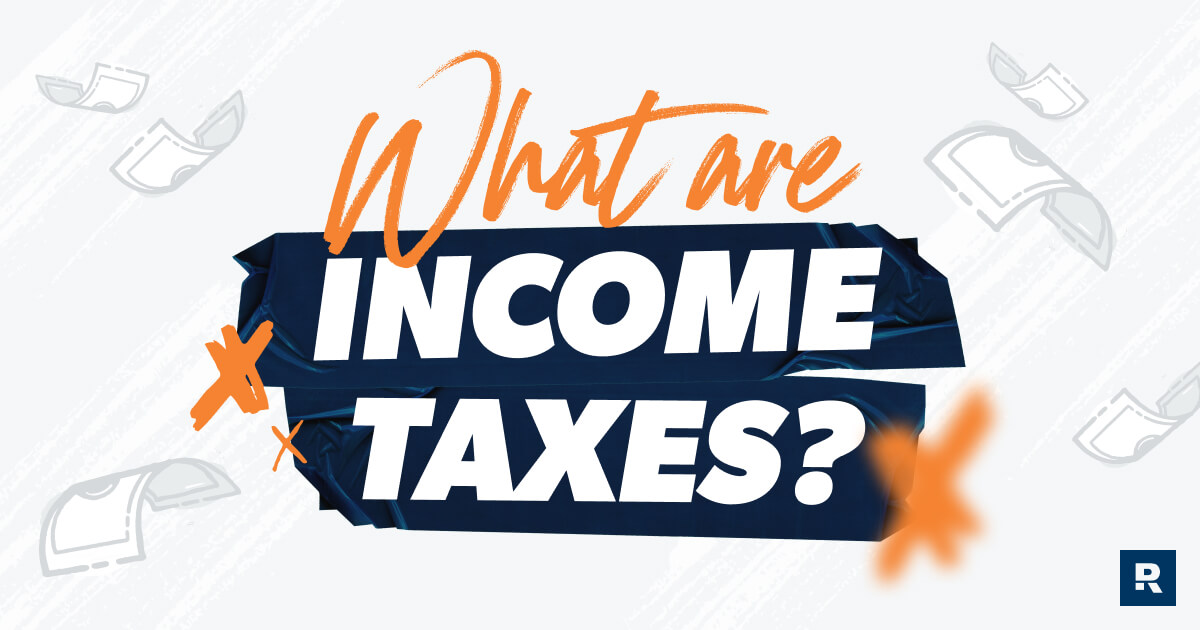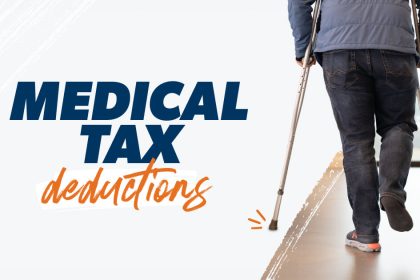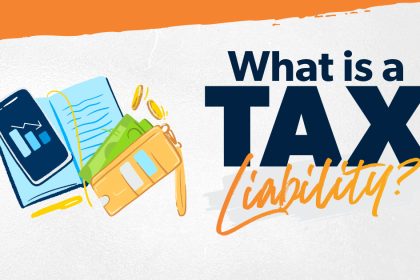Taxes . . . can’t live with ’em, can’t live (in America) without ’em.
Whether we like it or not, income taxes are as much a part of American life as baseball and apple pie. And while we groan and grumble as we fill out our tax returns every spring, our tax dollars help pay for a lot of the stuff we sometimes take for granted—like highways, schools and national parks.
Plus, if Uncle Sam doesn’t get his fair share by Tax Day, you’ll probably be hearing from the Tax Man. Trust us, you don’t want that.
It doesn’t look like income taxes are going anywhere anytime soon, so what are they, how do they work, and how do you figure out how much of your hard-earned cash is going to the IRS every year? Let’s take a closer look.
What Is an Income Tax?
An income tax is a tax the government collects from money earned by businesses and individuals throughout the year. How much you pay in taxes depends on how much money you make in a year.
In 2020, the IRS collected more than $1.8 trillion in individual income taxes and another $263.6 billion in income taxes from businesses. Together, those income taxes make up almost two-thirds of all the tax money Uncle Sam collects every year.1 That’s a lot of dough!
Those income taxes are collected by the IRS, and then your tax dollars are used to fund a whole smorgasbord of public services—everything from military spending and education to transportation and medical research. In fact, individual income taxes have been the single largest source of federal revenue since 1950.2 You’re welcome, Congress!
Where Did the Income Tax Come From?
Want someone to blame for your income tax bill this year? Look no further than Abraham Lincoln. Well, sort of.
While “death and taxes” might be the only things that are certain in life, it wasn’t always that way—at least not as far as income taxes are concerned. Income taxes as we know them today are actually barely more than 100 years old.
In a controversial move, the first version of the personal income tax in the U.S. was signed into law by Lincoln during the Civil War as a way for the Union to pay for its war effort. Although the tax was repealed once the war was over, the debate over whether an income tax was constitutional or not raged on for decades.
All of that changed in 1913. That was the year the 16th Amendment to the U.S. Constitution was ratified, legalizing the government’s right to collect a federal income tax. That same year, Congress passed legislation that made income tax a part of American life. The rest, as they say, is history.
How Do Income Taxes Work?
Alright, let’s go back to your high school civics class for just a second. The U.S. tax system is progressive—that’s just fancy tax talk that means the higher your taxable income, the more you’ll pay in income taxes.
Your tax rate (the percentages of your income that you pay in taxes) is based on which tax bracket (income range) you’re in. Here are the tax rates and tax brackets for the 2023 tax year.3
2023 Federal Income Tax Brackets and Rates for Taxable Income
|
Tax Rate |
Single Filer |
Married, Filing Jointly |
Married, Filing Separately |
Head of Household |
|
10% |
$0–11,000 |
$0–22,000 |
$0–11,000 |
$0–15,700 |
|
12% |
$11,000–44,725 |
$22,000–89,450 |
$11,000–44,725 |
$15,700–59,850 |
|
22% |
$44,725–95,375 |
$89,450–190,750 |
$44,725–95,375 |
$59,850–95,350 |
|
24% |
$95,375–182,100 |
$190,750–364,200 |
$95,375–182,100 |
$95,350–182,100 |
|
32% |
$182,100–231,250 |
$364,200–462,500 |
$182,100–231,250 |
$182,100–231,250 |
|
35% |
$231,250–578,125 |
$462,500–693,750 |
$231,250–346,875 |
$231,250–578,100 |
|
37% |
Over $578,125 |
Over $693,750 |
Over $346,875 |
Over $578,100 |
Let’s say you’re married filing jointly and your household taxable income (the portion of your total income that can be taxed) is $120,000. That puts you in the 22% tax bracket. But that doesn’t mean all of your income is taxed at 22%.
Don’t settle for tax software with hidden fees or agendas. Use one that’s on your side—Ramsey SmartTax.
That’s because U.S. tax rates are marginal, which just means that each tax rate applies to only part of your income. Some of your income is taxed at 10%, another piece at 12%, and so on depending on how high your income is.
So, for this example, after all the damage is done, you and your spouse owe $17,015 in taxes for the 2023 tax year. Here’s how the numbers break down:
| Tax Calculation for $120,000 Taxable Income (Married Filing Jointly) | ||
| Tax Bracket | Income x Bracket % | Taxes Due |
| 10% | $22,000 x 10% | = $2,200 |
| 12% | ($89,450 – $22,000) x 12% | = $8,094 |
| 22% | ($120,000 – $89,450) x 22% | = $6,721 |
Total Taxes Owed = $17,015
If you have questions about how much you owe in income taxes this tax season, you might want to get in touch with a trustworthy tax advisor who can help you figure out those numbers.
How Are Income Taxes Collected?
If you’re like most American employees with a salary, health benefits and a 401(k), your employer probably sets aside some money from your paycheck for income taxes before it hits your bank account (those are called tax withholdings).
Remember that W-4 tax form you filled out when you first got hired? Your employer uses the information you put on that form to figure out how much to withhold from each paycheck.
So, really, you’ve been paying the government your fair share in taxes for most of the year. (You can check your last paycheck to see just how much they’ve been sending to the IRS.)
When you fill out your tax return and file it with the IRS in the spring, you’ll find out if you still owe the government anything in taxes or if you overpaid and Uncle Sam owes you a tax refund.
Sounds simple enough, right? But what if you’re self-employed (think freelancers, independent contractors and small-business owners)? You’ll probably pay your income taxes through quarterly taxes—or estimated taxes—that you file with the IRS every three months. If you’re self-employed, you’ll want a tax pro who can help you throughout the year to answer all your tax questions!
What Are the Different Types of Income Tax?
We’ve been talking a lot about federal income taxes, but there’s a good chance those aren’t the only type of income taxes you have to worry about.
That’s right, depending on where you live and what kind of work you do, you might have to pay income taxes at the state level or at the corporate tax rate. Even some local governments want to get their hands on your paycheck.
Let’s take a deeper look at some of the different types of income taxes you might run into during tax season.
State Income Taxes
Uncle Sam isn’t the only one who wants a piece of your income. Like the federal government, most states also have their own income tax system. Yuck.
Where does your state income tax money go? More than half of state tax revenues are used to fund education and health care, in addition to other services like transportation, public assistance and prisons.4
Now, each state falls into one of three different categories—states with progressive income taxes, states with a flat income tax and states with no income tax at all. Let’s dive into each one.
1. States With Progressive Income Taxes
Just like at the federal level, most states have a progressive tax structure with marginal tax rates. Again, all that boils down to is this: The more you earn, the more you’ll be taxed.
Each state sets their own tax rates and tax brackets, so if you live in one of the 32 states with a progressive tax structure, pay attention to which tax bracket and tax rates you fall into for your state.
If you live in Hawaii, you could fall into one of 12 different tax brackets with tax rates between 1.4% and 11%. But Louisiana has just three tax brackets with tax rates between 1.85% and 4.25%. You might want to think about that before you move to a new state!5
2. States With Flat Income Taxes
There are 11 states that keep things simple. Really simple. They have a flat tax rate. That means it doesn’t matter how much or how little you earn—you’re taxed at the same rate as everyone else.
Let’s take a look at Kentucky, which has a flat 4.5% tax on income. If you made $50,000 last year and your neighbor brought in $500,000, both of you will be taxed 4.5% by the state of Kentucky.6
Here are the 11 states that have a flat income tax structure:
- Arizona
- Colorado
- Idaho
- Illinois
- Indiana
- Kentucky
- Michigan
- Mississippi
- North Carolina
- Pennsylvania
- Utah
3. States With No Income Tax
And then there are nine states that have no income tax at all! That’s more like it! Here are the nine states with no income tax:
- Alaska
- Florida
- New Hampshire
- Nevada
- South Dakota
- Tennessee
- Texas
- Washington
- Wyoming
New Hampshire doesn’t tax regular income but does tax any money you make from interest and dividends from your investments. Meanwhile, on the other side of the country, Washington has a flat tax that applies to capital gains income of high earners.
While not having a state income tax is nice, these states usually make up for lost revenue through other types of taxes, like sales taxes or property taxes, or reduced spending at the state level. Keep that in mind before packing up your stuff and crossing state lines!7
Business Income Taxes
Own a small business? How you pay taxes on the profits you make depends on how your business is set up.
If your business is a C corporation, your company’s income tax rate is a flat 21% thanks to the Tax Cuts and Jobs Act of 2018 (it was 35% before that bill passed).8
But if the business is a pass-through entity, such as a sole proprietorship or a limited liability company (LLC), you won’t pay corporate income taxes. The profits from your business “pass through” the business to you. So, you would fill out your personal tax return like you normally would and pay the taxes on those profits at your personal income tax rate.
Local Income Taxes
Although most U.S. cities and counties don’t add another layer of income tax on their residents, there are still more than 5,000 local jurisdictions across 16 states—particularly in the Midwest and Northeast—that charge an income tax as of 2019.9
These local income taxes are mostly imposed by counties, municipalities and school districts to pay for a wide range of civic services like parks, schools and even garbage collection.
A Better Way to File Taxes
If you live in a state with no income tax, have a simple tax situation, or just happen to be one of those unique individuals who likes using tax software, that’s great! Self-filing with Ramsey SmartTax makes it easy to file your return and take control of your taxes in a matter of minutes. You won’t be surprised by hidden fees and you won’t have to make sense of confusing tax jargon—what you see is what you get!
Learn how you can file your taxes with Ramsey SmartTax!
But hey, depending on where you live, you might have to deal with federal, state and local taxes . . . that’s a lot! If you’re feeling overwhelmed this tax season, work with one of our RamseyTrusted tax advisors who serves your area. That way, you can rest easy knowing you have a tax professional on your side who knows the tax code inside and out so you don’t have to.
Find a tax advisor who serves your area today!
Read the full article here






